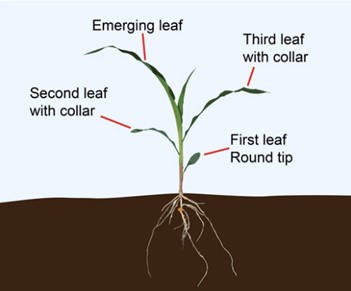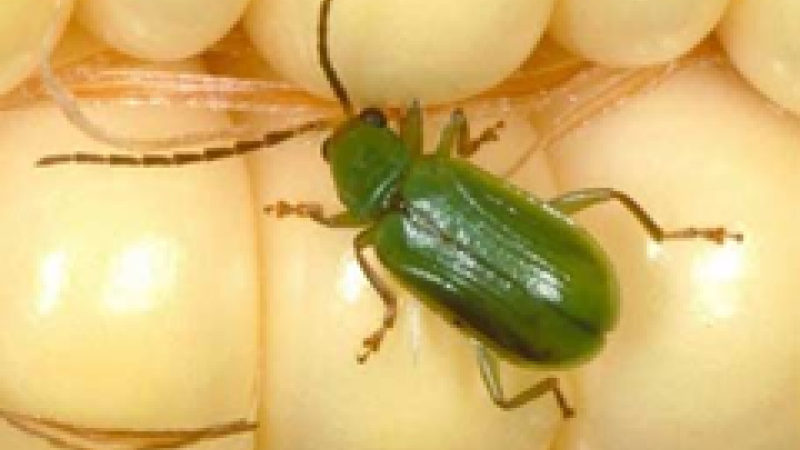Corn Growth & Development
This year has been another season of extreme weather from very little planted in the north and good planting conditions in the south to storms and possible replant in the middle of the Hoegemeyer footprint. Because of all these weather events and planting timings it is important to be able to stage your corn growth. Staging the corn growth enables you to understand when the optimal time is to apply fertilizers, spray post applied chemicals, spray fungicide and to scout for certain insects.
Corn growth stages are defined into two stages, first comes the vegetative stages (V) and reproductive stages (R). The vegetative stages are divided into substages V1, V2, V3, etc. identifying the number of leaf collars. The reproductive stages are divided into substages R1, R2, R3, etc. identifying ear development.
Staging A Corn Seedling
Each leaf stage is defined according to the uppermost leaf whose leaf collar is visible. The first part of the collar that is visible is the back, which appears as a discolored line between the leaf blade and leaf sheath. The characteristically oval-shaped first leaf is a reference point for counting upward to the top visible leaf collar.

Emergence & Stand Establishment
- VE Stage – This is emergence and takes place approximately 100-120 GDU’s or 4-5 days. The seed will need to take up approximately 30% moisture to begin germination.
- V1 Stage – The first leaf to become visible will have a rounded tip and all other leaves after that will be pointed. The leaf will come out approximately 3-4 days after VE.
- V2 Stage – Will take place approximately 200 GDU’s or 7-10 days after VE.
- V3-V6 Stages – Will take place approximately 475 GDU’s or about 21 days after VE. This marks the end of the seed being the main source of food for the plant and the beginning of photosynthesis and the nodal root for food. The number of kernel rows are being determined. Growing point is starting to come out of the ground.
- V7-V9 Stages – Will take place approximately 610 GDU’s. This is a good stage to do any foliar treatments because it is the beginning of rapid growth and nutrient uptake.
Rapid Growth & Dry Matter Accumulation
- V10-V13 Stages – The plant has entered its fast growth stage. New leaves or V stages will happen every 2-3 days. Water and nutrient demand is great during this period. As growth works it way to V13 the ear will determine how long the kernel rows will be and complete the determination of ear size. In general, earlier season hybrids will move through these stages in less time. We will be a good 6 weeks after emergence.
- V14-V(n) – This is the final stages of the vegetative growth of the corn plant. Depending on growing conditions and the location of the field in the corn belt will determine the number of leaves on the plant. In general, most plants will be around 16-22 leaves. At V15 there is only 12-15 days until the reproductive stages begin. Root growth is ramped up to support the taller plant with an ear. Roots could reach 5-8 feet deep at this point.
Pollination
- VT Stage – This is when the tassel is completely visible. The tassel will appear 2-3 days prior to silk emerging R1. Pollen shed normally occurs during the late morning or early evening. This is when most fungicides are recommended to be applied.
- R1 Stage – Silks will appear, and pollination will begin. This process normally takes 2 -3 days. There is rapid uptake of nitrogen and phosphorus.
Grain Fill
- R2 Stage – Blister looking kernel is forming on the cob and will continue to grow through R6. The cob is in its full size.
- R3 Stage – Milk occurs about 18-22 days after R1. Corn kernels will start to yellow and the kernel growth will occur from cell expansion and starch accumulation.
- R4 Stage – Dough is when the kernels start to thicken and accumulated 50% of their dry weight.
- R5 Stage – Dent the kernel is around 55% moisture. This is where livestock producers will watch for the milk line to move from the top of the kernel to the tip for silage cutting.
- R6 Stage – Physiological maturity has been achieved about 55-65 days after R1. The tip of the kernel will appear black and is called black layer. The kernel moisture at this point is 30-35% and dry down for grain harvest will start.
Corn development stages is an important part of managing your crop throughout the year. Today you need to know when it is safe to spray your post herbicides and to understand when the plant needs the most fertility. As you can see above the ear determines the number of kernels two different times during its growth, V6 and V12. Understanding your corn fields and hybrids give you a much better chance of managing corn development for a greater chance of higher yields.

